Industrial Grid Tied Solar Solutions
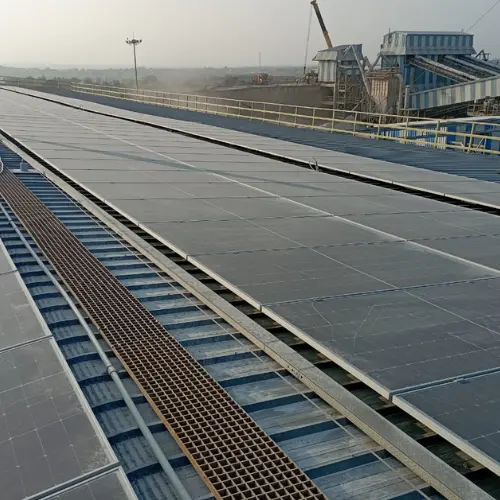
Industrial operations are energy-intensive, and rising electricity costs are a major challenge. An industrial grid-tied solar system offers a sustainable, cost-effective solution by allowing industries to generate electricity on-site while remaining connected to the utility grid.
These systems are real-time applicable, meaning your facility can automatically use solar power during peak daylight hours and switch to grid power during low production periods, ensuring uninterrupted operations.
Industries from textiles, manufacturing, logistics, IT, and commercial complexes benefit from:
- Reduced energy costs
- Reliable power availability
- Environmental compliance
- Long-term financial savings
Keyword focus: industrial solar panels, grid-tied solar system for factories, on-grid solar energy for industries
How Industrial Grid-Tied Solar Systems Work
A grid-tied system is a smart integration of solar technology with the local electricity grid. Here’s how it operates in real-time:
Solar Panels: The system consists of photovoltaic (PV) solar panels that convert sunlight into direct current (DC) electricity.
Inverter: The inverter then converts this DC electricity into alternating current (AC), which is compatible with the electrical grid and industrial machinery.
Utility Grid Connection: Excess electricity generated by the system is fed back into the grid, allowing industries to potentially earn credits from the utility company.
Power Consumption: During insufficient solar production, power is automatically drawn from the grid to ensure seamless operation of the industrial facility.
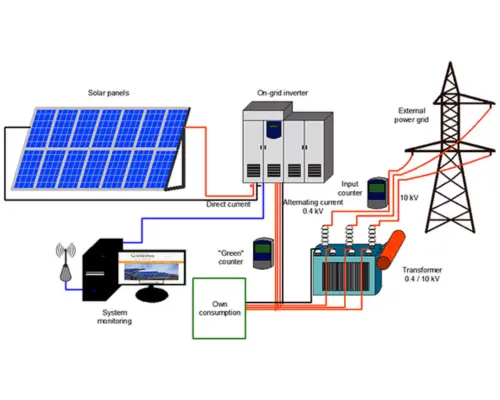
Benefits of Grid-Tied Solar Systems for Industries
Lower Energy Costs
- Solar energy can reduce 30–50% of electricity bills, depending on consumption patterns.
- Surplus power sent to the grid can create an additional revenue stream.
Minimal Maintenance
- Unlike diesel generators or hybrid systems, grid-tied solar requires less ongoing maintenance.
- Panels require periodic cleaning and inverter checks only.
Scalability
- Systems can be incrementally expanded to meet growing energy requirements.
- Ideal for phased industrial expansion or multi-building facilities.
Environmental Sustainability
- Supports ESG and CSR initiatives by reducing carbon footprint.
- Helps industries achieve compliance with renewable purchase obligations (RPOs).
Reliable and Seamless Power Supply
- Automatic switching between solar and grid ensures continuous operation.
- Eliminates downtime due to fluctuating solar production.
Key Components of a Grid-Tied Industrial Solar System
High-Efficiency Solar Panels
- Typically monocrystalline or polycrystalline panels with 20–25 years lifespan.
- Resistant to dust, temperature variations, and industrial pollutants.
Industrial-Grade Inverters
- String inverters or central inverters designed for large-scale power conversion.
- Capable of supporting heavy industrial loads and complex machinery.
Grid Synchronization & Energy Banking Equipment
- Ensures safe export of surplus energy to the grid.
- Protects against voltage fluctuations and ensures regulatory compliance.
Monitoring & Control Systems
- Industrial SCADA systems or smart apps provide 24/7 operational insights.
- Helps in identifying inefficiencies and optimizing energy usage.
Industrial Applications of Grid-Tied Solar
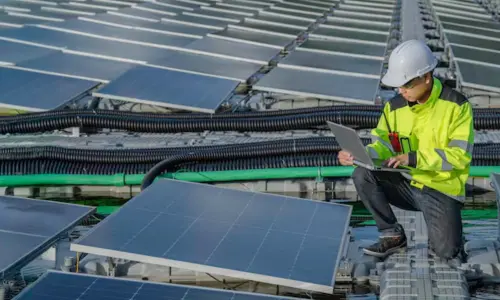
Manufacturing Facilities
- Factories consume large amounts of energy during production hours.
- Real-world example: A textile factory installing a 1 MW grid-tied system reduced its peak-hour energy cost by 45%, achieving ROI in just 4 years.
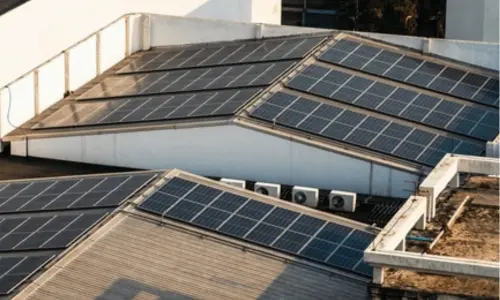
Warehouses & Logistics Parks
- Large rooftops and open spaces are ideal for industrial solar installation.
- Real-world application: A logistics warehouse powers lighting, HVAC, and automation systems with solar energy, cutting grid dependency and reducing carbon footprint.

Data Centers
- Data centers have high 24/7 power demands, making them ideal candidates.
- Benefit: Provides clean energy, reduces electricity costs, and improves sustainability metrics.
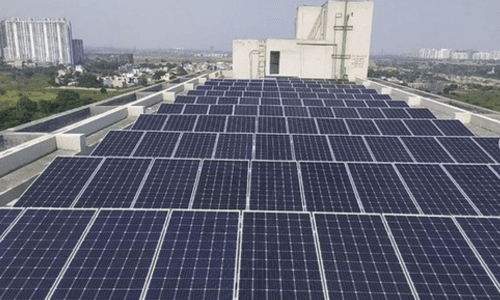
Commercial Complexes & Industrial Parks
- Multiple buildings with high cumulative load can leverage a centralized grid-tied solar system.
- Outcome: Reduces total energy bills and supports LEED and green building certifications.
Challenges of Grid-Tied Solar Systems
Grid Dependency
- Systems cannot supply power during outages without batteries.
- Solution: Hybrid grid-tied systems with backup storage.
Initial Investment
- High upfront cost for panels, inverters, and installation.
- Real-world tip: Financial incentives and long-term ROI often justify the investment.
Space Requirements
- Large-scale industrial systems require substantial rooftop or ground area.
- Solution: Vertical installations, dual-use rooftops, or ground-mounted arrays.
Subsidies for Industrial Hybrid Solar Systems in India
- PM Surya Ghar Muft Bijli Yojana
1. Benefit: Subsidy up to ₹78,000 for rooftop solar installations; provision of up to 300 units of free electricity per month. - PM-KUSUM Yojana (Kisan Urja Suraksha evam Utthaan Mahabhiyan)
1. Benefit: Up to 60% subsidy for solar pumps; 30% loan assistance; farmers contribute only 10% of the total cost. - Grid-Connected Rooftop Solar Programme
1.Benefit:
o 40% subsidy for systems up to 3 kW.
o 20% subsidy for systems between 3 kW and 10 kW.
o Only empaneled vendors and MNRE-approved models qualify - Production Linked Incentive (PLI) Scheme for High-Efficiency Solar PV Modules
1. Benefit: Financial incentives to manufacturers based on sales, promoting the use of locally produced solar components.
Why Choose Us for Industrial Solar Solutions?
Proven Expertise
Years of experience in large-scale solar projects for industries.
Financial Guidance
Assistance in claiming subsidies, tax benefits, and ROI calculations.
Premium Technology
Tier-1 solar panels and globally trusted inverters.
Sustainability Commitment
Partnering with you to achieve long-term green energy goals.
Custom Engineering
Tailored designs based on your factory’s load profile.
End-to-End Support
From site survey and design to installation and after-sales service.
Frequently Asked Questions
What is the return on investment (ROI)?
Industries typically achieve ROI in 3–5 years, with decades of free solar power afterward.
How much area is required for a 1 MW industrial solar plant?
Approximately 4–5 acres for ground-mounted or 100,000 sq. ft. of rooftop space, depending on design.
Can my industry operate if there is a power outage?
A pure grid-tied system shuts down during outages for safety. For uninterrupted power, choose a hybrid solar solution with battery storage.
What is the typical lifespan of an industrial grid-tied solar system?
Solar panels last 25–30 years, with inverters requiring replacement every 10–12 years.
